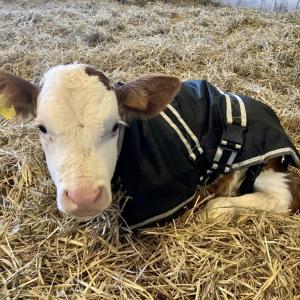
By vet Dan Lawson
Pneumonia in calves is a major problem associated with raising calves, it accounts for 22.5% of all deaths in pre-weaned calves.
Calf pneumonia results in increased costs, in the short term there is increased feed costs with a decrease in liveweight gain and feed conversion. Alongside these initial losses there is also a knock-on effect to these calves with an increased age at first calving.
Common diseases that cause calf pneumonia are bovine respiratory syncytial virus, parainfluenza-3 virus, infectious bovine rhinotracheitis and mycoplasma bovis.
There are many steps that you can take to help reduce the incidence of calf pneumonia; these are at the individual level, group level and also incorporating the buildings.

Colostrum is key to a good start in life. Calves should receive 10% of their bodyweight within 6 hours of birth. This needs to be good quality colostrum, you can test the quality of the colostrum using a refractometer, the colostrum should be >55g/l.
Care also needs to be taken to ensure adequate good nutrition is provided including using a good quality milk replacer, concentrate and forage. It is also important to adapt to changing weather conditions for example during cold weather. For every 5ᵒC drop below 15ᵒC calves need an extra 50g of milk replacer a day.
Building design is crucial to providing the right start to life for your calves. There needs to be a constant source of fresh air coming in to replace stale air. The air speed can be measured at multiple points and smoke pellets can be used to observe how quickly the air dissipates. One way this can be achieved is by using a positive pressure tube ventilation system. Draughts must also be avoided, use of solid barriers at calf height can help to achieve this. Small alterations can help to have a large impact on calf health.
High humidity can also lead to increased incidence of pneumonia as there is increased pathogen survival. Therefore, controlling moisture in the sheds can is essential, this in part requires good ventilation and good drainage.
The calves also require a sufficient bedding to allow them to nest in. Calf jackets are another great way to help calves maintain their temperature. Calves that are less than 3 weeks old, benefit from jackets when the temperature drops below 15ᵒC, however jackets are recommended for calves over 3 weeks old if the temperature is below 5ᵒC.
Vaccination is an invaluable tool to assist in managing and getting a better control over pneumonia diseases that affect calves. However they can’t be used in isolation to battle calf pneumonia. Before making the decision to vaccinate and with what, you must consider what disease is causing the pneumonia in the calves, therefore testing is needed to identify this. It is best to take nasopharyngeal swabs of calves that haven’t yet been treated. A post mortem can also be an invaluable tool in identifying the diseases involved in causing the pneumonia. These results can help to select the best vaccine for your farm.
Calf pneumonia is a major issue that has both short and long term consequences, that leads to increased costs. There are many steps that can be taken to help reduce the number of cases of calf pneumonia; no one step will solve the problem however small changes can help to reduce the disease burden in the sheds and therefore reduce the number of pneumonia cases that are seen.